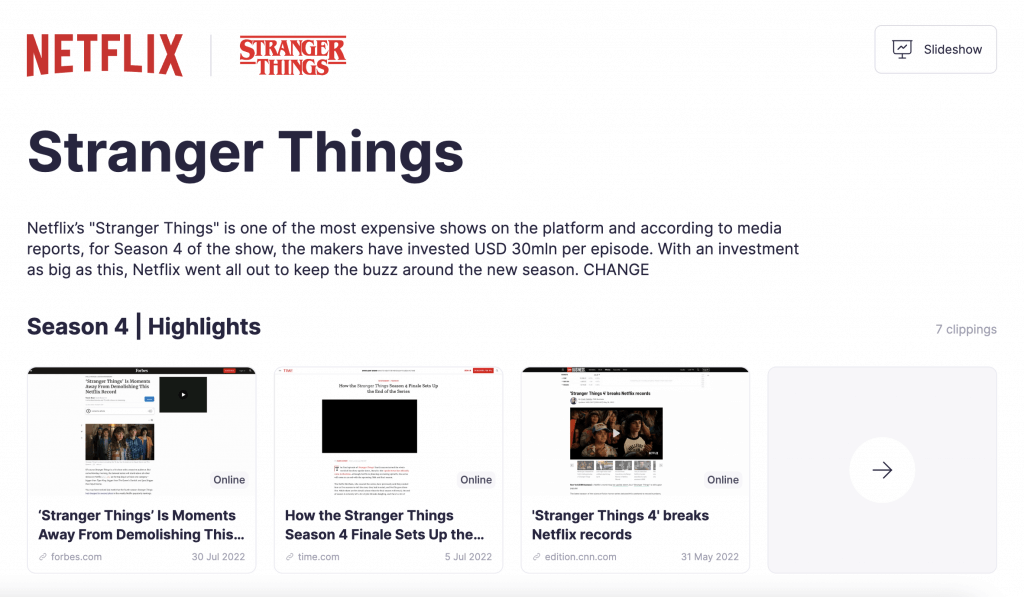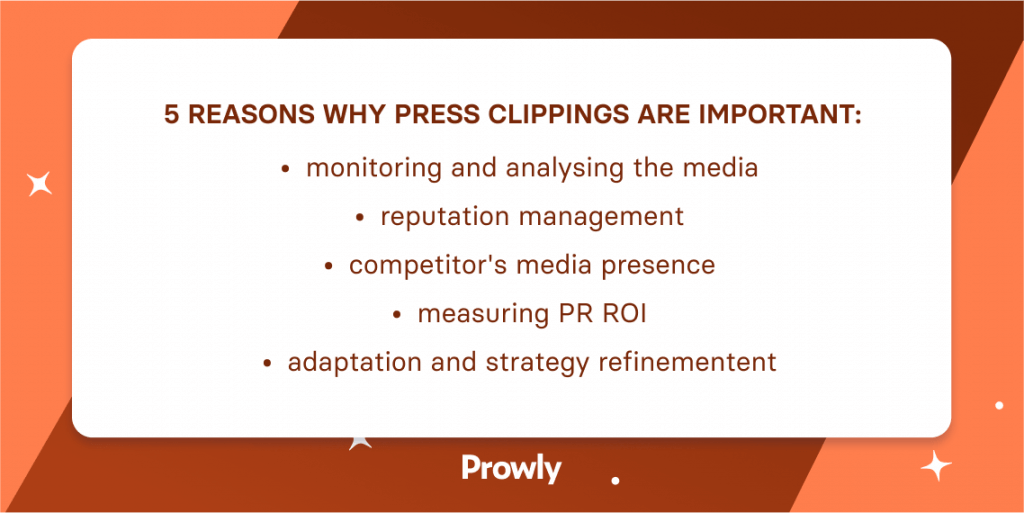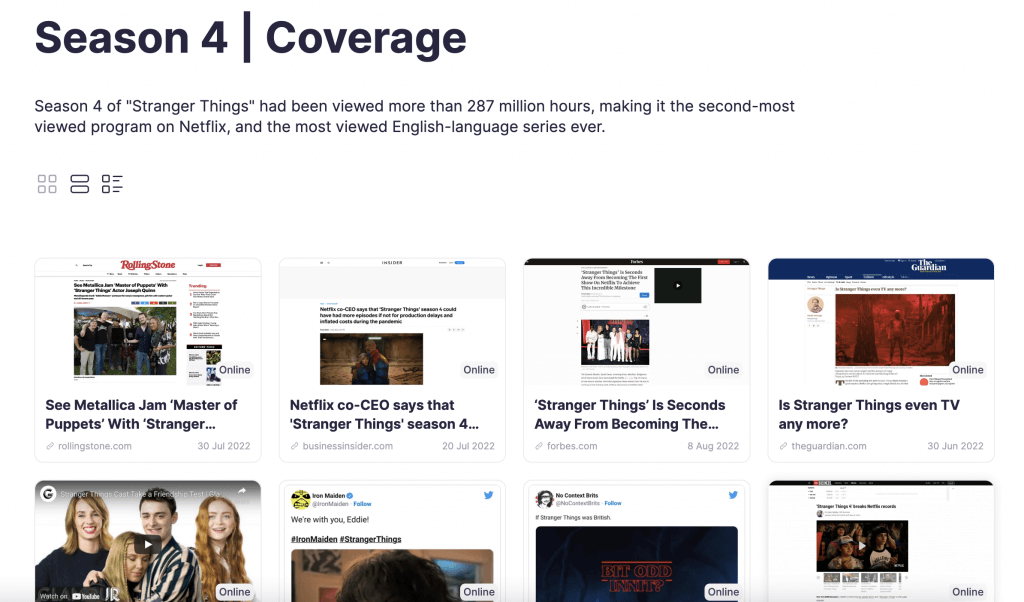Remember the good ol’ days of cutting out pieces of articles from newspapers and magazines? Since technology has progressed though, it’s nearly certain you’ve been using a dedicated tool to collect mentions and don’t need a scissor and glue combo nearby.
Collecting PR clippings is important if you want to stay up to date with the latest mentions you’re interested in, track competitors, analyze your strategy, and report on progress to clients or stakeholders. And you will learn all that from this article.
- What is PR clipping?
- 5 reasons why press clippings are important
- PR clipping purposes and benefits
- How to make a media clipping with Prowly?
- How to do PR clipping
- FAQ
Start collecting relevant press clippings right away, or get to know all the details first.
What is PR clipping?
The method sounds more complex than it is, but it’s something you’ve probably done already plenty of times.
Definition of PR Clipping
PR clipping is a method of collecting mentions from media content. It often includes an analysis of public relations activities and the effectiveness of strategies in place. The process itself is often followed by creating a comprehensive coverage report.
For example, your client is interested to see how a recent product announcement campaign performed.

By analyzing mentions, you can find out the audience such news reached, which social media platform had the most engagement, and whether all the activities around the campaign produced a good return on the investment.
5 reasons why press clippings are important
Take a look at why you should be collecting, tracking, and analyzing press clippings.

1️⃣ Media monitoring and analysis
The process plays a crucial role in monitoring the media, which allows brands to track how they’re portrayed in all kinds of media channels, including online and offline sources. Without a PR clipping tool, it’s nearly impossible to be able to catch all mentions of your brand and analyze them later.
Because of the expansion of the digital landscape, imagine going through online press clippings by hand – you’d probably have to hire a dedicated person (or a few people!) to do so.
Instead, you can do media monitoring with special tools and see what’s the sentiment of your brand across various platforms, monitor your share of voice, see the estimated reach of your earned media, and so on.
2️⃣ Reputation management
To expand a bit more on the previous paragraph, careful evaluation of PR clippings is important for brand reputation management.
When you’re focused on a specific platform, you might be missing out on your audience’s sentiment in different places. With press clipping services, this becomes a click of a button rather than a tiresome task.
Media monitoring tools provide analysis such as sentiment, so you can see if there’s an unusual spike in any kind of mentions or an increase in negative mentions (and if that happens, you know it’s emergency showtime).

3️⃣ Competitor’s media presence
How do you know if you’re doing a great job if you’re not monitoring what your competitors are doing? Yes, you can compare results to your own benchmarks, but knowing what’s happening with your rivals is one of the most important benefits of collecting mentions.
What does it mean exactly?
👉 If a competitor has a really strong presence in niche outlets, and none in higher tier ones, maybe it’s time to target those niche outlets as well or re-organize your strategy to prepare send-outs for other media your audience frequents.
4️⃣ Measuring PR ROI
You sure don’t need to be reminded of the media report definition, but it’s important to recall how important measuring your strategy is. Whether you want to score a higher budget for the next campaign, or simply show off your work to stakeholders and clients, press clippings can help you do just that.

Advanced press clipping service companies have the technology to take a clipping and pull all the data about it.
Pro Tip: Additionally, if there is a group of clippings you’re analyzing, it’s a good idea to compare them to previous periods and show clear improvements, or simply assess them from a strategic standpoint aligned with the company goals.
5️⃣ Adaptation and strategy refinement
Are you reaching your goals effectively?
You can only see if there’s room for improvement, or if your strategy is right where it’s supposed to be by analyzing press clippings.
👉 The general consensus is to monitor them at least once a day, depending on the size of the brand you’re working with.
👉 If things are rather stagnant, you can adjust your actions by analyzing statistics for each one of the press clippings.
Since advanced PR tools allow you to monitor mentions and analyze them in bulk, you no longer have to go one by one and do it all on your own.
And if you have more concerns regarding social listening techniques, you will learn all about building a strong social media monitoring strategy from this guide.
Press clipping purposes and benefits
This popular method offered by media monitoring services can help you increase brand awareness by analyzing each press clipping and adjusting your PR strategy accordingly.
With press clipping services offered by tools like Prowly, it’s easy to stay in the know and make informed decisions on the fly.
Instantly identifying opportunities
Ever struggled to find exciting opportunities in the media?
With a media clipping service, you can quickly detect new trends and emerging talks across various channels. That way, you can either contribute or even initiate discussions that align with your brand’s goals.
To put it in perspective, let’s say you get an alert for a spike in mentions on Facebook.
Not all social media monitoring platforms are created equal, and some audiences are more sympathetic towards certain communities than others.
👉 If the buzz is already on Facebook, you can contribute to it there, and see if there’s potential to create the same hype across different channels too.
Measuring campaign performance
First of all: 🚩 if a tool isn’t able to give you PR-specific, industry-relevant numbers, then you might need to reconsider the online press clipping service you’re using. 🚩
With a good press clipping tool, you’ll be able to assess how your campaign is performing. After all, data-driven insights provide great results to keep doing what we’re doing if it’s working or shift our strategy when things are going south.
For example, Prowly’s Media Monitoring can provide you with data-driven insights that you can analyze and use to build trust among stakeholders by providing them with timely and accurate updates on campaign performance.
The topic of data-driven PR is too important to simply glide through in this article. So, here’s a comprehensive step-by-step guide on how to measure your PR campaigns instead.
Acting in real-time
The ability to respond in real-time is the key to success. PR clipping services empower specialists with technology that systematically gathers and analyzes mentions scattered across various sources.
Whether you aim to be one step ahead if there is an impending crisis, or you simply want to be up to date with all mentions, collecting PR clippings is a great method to do so.
More so, acting in real-time based on PR clippings is not only a crisis response mechanism – it also serves as a tool to craft strategic initiatives to increase brand awareness.
Using data insights to optimize PR campaign strategies
Analyzing press clippings helps in understanding the customer’s perspective and the audience you’re interacting with. By using data-driven insights, you can adjust PR strategies and see how to improve them in the short term, or in the long run.
Prowly’s Media Monitoring tracks mentions of any brand, competitor, or keyword, compiling them all in a comprehensive report with different charts.
That way, it’s easier to visually analyze data and make informed decisions moving forward.
Adjusting strategy based on competitor’s actions
One of the biggest purposes of PR clipping services is to monitor your competitors.
Knowing who’s up to what is a great benchmark to use in evaluating your strategy. As you look over press clipping examples of your key rivals, you can gain a competitive edge quickly, especially if you know how to track media mentions effectively.
Then, it’s all about aligning what you have seen and analyzing it with alignment to the company’s goals:
👉 Is it brand awareness in general?
👉 Or maybe continuous work on increasing positive sentiment in one particular platform?
Whatever it is, PR clipping services are wonderful at evaluating what’s happening in different brands.
Reporting back to clients and stakeholders
There’s no better way to show others your work than in a comprehensive press clippings report. To demonstrate your value, press clipping services should have an additional option to create easy-to-read PR reports, so that you can create a presentation for whoever is in charge in a few clicks.

PR Reports allow you to automatically add important PR clippings and generate a coverage report with your work.
Whether your goal is to show that your strategy is in alignment with organizational goals, or simply build trust and transparency with data-driven insights, a clear PR report is the best way to do it.
For example, by combining media monitoring with PR clippings, you can track your campaign during a new season of the TV series your company has just launched and monitor the earned buzz surrounding it simultaneously.
➕ Bonus: blocking domains to see only the relevant clippings
Constantly getting mentions from an outlet you couldn’t care less about?
Blocking irrelevant outlets and excluding them from your statistics during Media Monitoring can help you ease the process.
Once you block a domain, it will not show up in any of your search queries, data or statistics.
Then, the clippings feature lets you choose which mentions are important to you right from the search query results, having them within reach for quick access. Here’s what it looks like in Prowly:
How to make a media clipping with Prowly?
Prowly is a comprehensive tool with a full workflow for PR professionals. With all the features available, it also provides you with a media monitoring service to assist you in collecting press clippings.
- Choose an article, blog post, mention, or any other clipping you like
- Add it to a report and automatically pull the data you want to show
- Finish making your report to show off your work
How to do PR clipping?
Take a look at what the process looks like from beginning to end.
1. Choose from one of the media monitoring services
First, find a tool that allows you to do PR clippings. For example, Prowly provides a free trial so you can try it out and see how easy it is to collect mentions automatically in less time.
2. Create a relevant query
Choose what you want to track. It can be a person, brand, competitor, or keyword – options here are limitless. Additionally, you can create an alert and get it sent to your mailbox whenever there’s a new mention or an unusual spike of clippings with a negative sentiment so you can react to an impending crisis quickly.
3. Collect and analyze PR clipping results
Access an easy-to-read dashboard with all of the results. You can break it down by country, language, domain rank, and in dozens of other ways. If the tool has the option to view data in different types of graphs (Prowly does!), it makes it easier to understand what’s going on.

4. Build an automatic report
Automatically transfer the PR clippings you found into a coverage report, where you can add a solid summary of all the data and metrics.
Putting all of your campaign accomplishments into a data-filled report will surely impress any client or stakeholder.
However, it’s also important to use the relevant PR metrics that show the real value of your work. For example, we suggest stopping the use of UVPM or AVE alone and instead trying out their alternatives, including Share of Voice, sentiment, or media mentions.
FAQ
Who is PR clipping important for?
A clippings manager tool is important for every PR specialist tasked with social listening. Whether you’re a solo freelancer, an agency, or an in-house team, collecting PR clippings allows us to adjust strategies on how we communicate with our audience.
Which tools can help with PR clipping?
There are several tools available on the market:
- Google Alerts
- Prowly
- Brand24
- Mentionlytics
What is an example of a press clipping?
So, what is a press clipping? It’s simply a part of an article, a feature, or a mention from anywhere in the media. It’s most commonly used when you need to make a report or a presentation for clients or stakeholders.
You can see three PR clippings in the “Highlights” section on the screenshot below.
Wrapping up
Thanks to technology, we don’t need to do PR clipping manually anymore, but the idea of collecting mentions stays and isn’t going anywhere.
From being able to see the sentiment of your activities in the media, to tracking competitors and keeping up with what’s going on with your audience. Press clipping is an indispensable industry method for anyone who works in public relations.
Start a free trial with Prowly and track press clippings of brands, competitors, or any keywords you’re interested in.


